Deck 12: Major Transitions
Question
Question
Question
Question
Question
Question
Question
Question
Question
Question
Question
Question
Question
Question
Question
Question
Question
Question
Question
Question
Question
Question
Question
Question
Question
Question
Question
Question
Question
Question
Question
Question
Question
Question
Question
Question
Question
Question
Question
Question
Question
Question

Unlock Deck
Sign up to unlock the cards in this deck!
Unlock Deck
Unlock Deck
1/42
Play
Full screen (f)
Deck 12: Major Transitions
1
In what way are single-celled slime mold amoebas and individual honeybees (social insects that live in colonies)alike?
A)Signals cause them to aggregate, though they usually live alone.
B)They are both examples of loss of complexity.
C)Individuals always live in groups.
D)Some individuals give up independent replication in the larger group.
A)Signals cause them to aggregate, though they usually live alone.
B)They are both examples of loss of complexity.
C)Individuals always live in groups.
D)Some individuals give up independent replication in the larger group.
D
2
Which of the following is not an organelle that is the result of endosymbiosis?
A)Mitochondrion
C)Apicoplast
B)Chloroplast
D)Endoplasmic reticulum
A)Mitochondrion
C)Apicoplast
B)Chloroplast
D)Endoplasmic reticulum
D
3
Which of the following statements regarding complexity is true?
A)Evolution always progresses toward complexity.
B)Complexity, once gained, cannot be lost.
C)Modern bacteria and archaea are more complex than ancestral forms.
D)Complexity can be lost.
A)Evolution always progresses toward complexity.
B)Complexity, once gained, cannot be lost.
C)Modern bacteria and archaea are more complex than ancestral forms.
D)Complexity can be lost.
D
4
Transfer of genes between organelles and the nucleus
A)occurred only in the distant past.
B)only happens between the mitochondria and the nucleus.
C)only happens between the chloroplast and the nucleus.
D)is ongoing.
A)occurred only in the distant past.
B)only happens between the mitochondria and the nucleus.
C)only happens between the chloroplast and the nucleus.
D)is ongoing.

Unlock Deck
Unlock for access to all 42 flashcards in this deck.
Unlock Deck
k this deck
5
The cell nucleus likely originated from a(n)
A)mitochondrion.
C)bacterium.
B)archaeal cell.
D)eukaryote.
A)mitochondrion.
C)bacterium.
B)archaeal cell.
D)eukaryote.

Unlock Deck
Unlock for access to all 42 flashcards in this deck.
Unlock Deck
k this deck
6
What unites the organisms shown in the figure below? 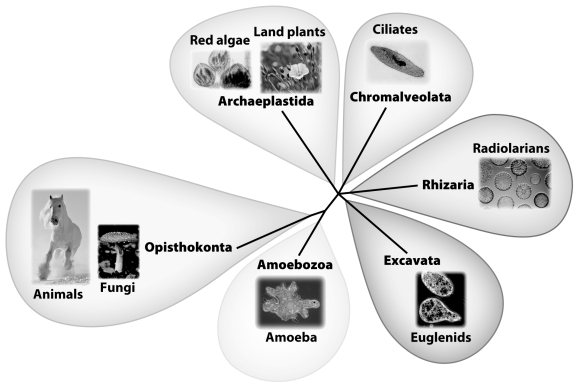
A)They are all single celled.
C)They are all archaea.
B)They all have chloroplasts.
D)They are all eukaryotes.

A)They are all single celled.
C)They are all archaea.
B)They all have chloroplasts.
D)They are all eukaryotes.

Unlock Deck
Unlock for access to all 42 flashcards in this deck.
Unlock Deck
k this deck
7
A somatic cell is
A)a body cell that is responsible for growth and maintenance.
B)a cell specialized for reproduction.
C)one of the cells that produces spores in slime mold fruiting bodies.
D)a cell that has four membranes around it.
A)a body cell that is responsible for growth and maintenance.
B)a cell specialized for reproduction.
C)one of the cells that produces spores in slime mold fruiting bodies.
D)a cell that has four membranes around it.

Unlock Deck
Unlock for access to all 42 flashcards in this deck.
Unlock Deck
k this deck
8
Which of the following statements about multicellularity is true?
A)Major eukaryotic groups either contain only multicellular or only unicellular species.
B)Eukaryotes became multicellular upon endosymbiosis with bacteria.
C)Multicellularity has evolved many times in eukaryotes.
D)Multicellularity is always advantageous for the individual.
A)Major eukaryotic groups either contain only multicellular or only unicellular species.
B)Eukaryotes became multicellular upon endosymbiosis with bacteria.
C)Multicellularity has evolved many times in eukaryotes.
D)Multicellularity is always advantageous for the individual.

Unlock Deck
Unlock for access to all 42 flashcards in this deck.
Unlock Deck
k this deck
9
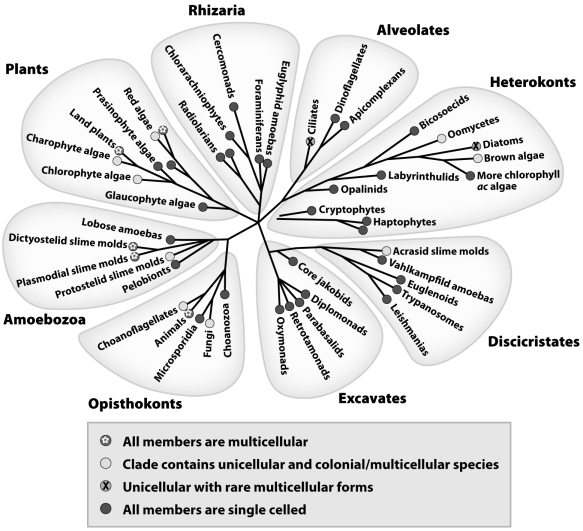 Basis on the figure above,multicellularity in plants and opisthokonts
Basis on the figure above,multicellularity in plants and opisthokontsA)has the same evolutionary origin.
B)is independently derived in each lineage.
C)is fixed within the each lineage (all organisms are multicellular).
D)originated in the amoebozoa.

Unlock Deck
Unlock for access to all 42 flashcards in this deck.
Unlock Deck
k this deck
10
The transition to multicellularity
A)has occurred once.
B)is an obligate condition.
C)occurs only in slime molds.
D)must convey a selective advantage to individuals if it is to occur.
A)has occurred once.
B)is an obligate condition.
C)occurs only in slime molds.
D)must convey a selective advantage to individuals if it is to occur.

Unlock Deck
Unlock for access to all 42 flashcards in this deck.
Unlock Deck
k this deck
11
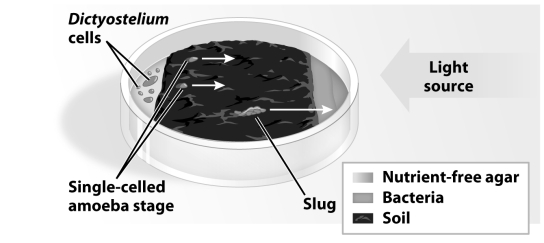 The experimental set up in the figure above was designed to test
The experimental set up in the figure above was designed to testA)the economy of scale of slime mold slugs and amoebas.
B)the reproductive ability of slime mold slugs and amoebas.
C)the aggregation ability of amoebas.
D)attraction of Dictyostelium to light.

Unlock Deck
Unlock for access to all 42 flashcards in this deck.
Unlock Deck
k this deck
12
According to the graph below,which of the following relationships between cell-type numbers is correct? 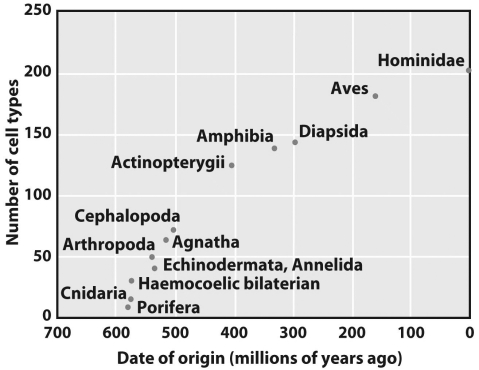
A)Hominidae < Aves
C)Cnidaria < Porifera
B)Cephalopoda < Actinopterygii
D)Amphibia < Echniodermata

A)Hominidae < Aves
C)Cnidaria < Porifera
B)Cephalopoda < Actinopterygii
D)Amphibia < Echniodermata

Unlock Deck
Unlock for access to all 42 flashcards in this deck.
Unlock Deck
k this deck
13
Which of the following is an advantage of the economy of scale?
A)Division of labor
C)Sexual reproduction
B)More individuals per group
D)Multicellularity
A)Division of labor
C)Sexual reproduction
B)More individuals per group
D)Multicellularity

Unlock Deck
Unlock for access to all 42 flashcards in this deck.
Unlock Deck
k this deck
14
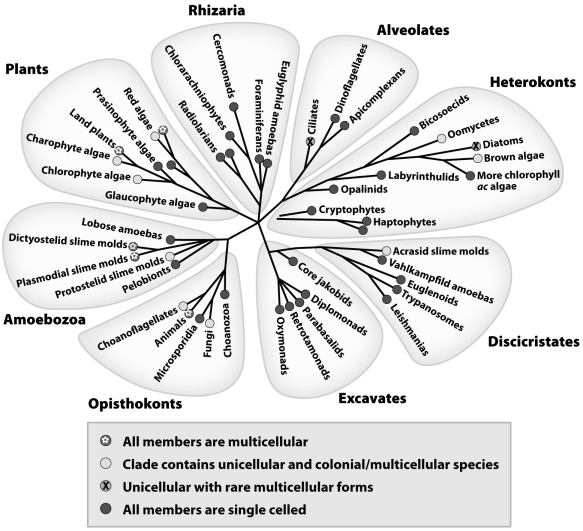 Basis on the figure above,multicellularity has evolved
Basis on the figure above,multicellularity has evolvedA)once.
C)three times.
B)twice.
D)at least six times.

Unlock Deck
Unlock for access to all 42 flashcards in this deck.
Unlock Deck
k this deck
15
Which of the following is a benefit of multicellularity for slime mold amoebas?
A)Self-sacrifice for other amoebas
C)Sexual reproduction
B)Ability to move quickly
D)Ability to feed on bacteria
A)Self-sacrifice for other amoebas
C)Sexual reproduction
B)Ability to move quickly
D)Ability to feed on bacteria

Unlock Deck
Unlock for access to all 42 flashcards in this deck.
Unlock Deck
k this deck
16
The chemical signal for slime mold amoebas to aggregate is
A)cAMP.
C)cGMP.
B)cCMP.
D)cTMP.
A)cAMP.
C)cGMP.
B)cCMP.
D)cTMP.

Unlock Deck
Unlock for access to all 42 flashcards in this deck.
Unlock Deck
k this deck
17
Economies of scale occur in major transitions when
A)individuals aggregate.
B)groups can perform tasks more efficiently than individuals.
C)cell-type number increases.
D)genes become genetically imprinted.
A)individuals aggregate.
B)groups can perform tasks more efficiently than individuals.
C)cell-type number increases.
D)genes become genetically imprinted.

Unlock Deck
Unlock for access to all 42 flashcards in this deck.
Unlock Deck
k this deck
18
Charles and Mary Brown have proposed that one reason cliff swallows live in colonies is that colonies serve as information centers.As a bird returns to its nest with food,other adults can observe the prey caught and follow the bird to where it is foraging,thereby increasing individual foraging success.This fits with which of Maynard Smith and Szathmary's processes of major transitions?
A)Economies of scale
B)Sacrifice of the ability to reproduce
C)Information transfer
D)The evolution of developmental complexity
A)Economies of scale
B)Sacrifice of the ability to reproduce
C)Information transfer
D)The evolution of developmental complexity

Unlock Deck
Unlock for access to all 42 flashcards in this deck.
Unlock Deck
k this deck
19
According to the endosymbiotic theory,early eukaryotes acquired the mitochondrion from a symbiotic bacterium.What happened to the bacterial genes?
A)All of the bacterial genes were lost.
B)All of the bacterial genes were transferred to the nuclear genome.
C)All of the bacterial genes still exist and comprise the mitochondrial genome.
D)All of the bacterial genes still exist and comprise the chloroplast genome.
E)Some bacterial genes were transferred to the nucleus, some were lost, and some comprise the mitochondrial genome.
A)All of the bacterial genes were lost.
B)All of the bacterial genes were transferred to the nuclear genome.
C)All of the bacterial genes still exist and comprise the mitochondrial genome.
D)All of the bacterial genes still exist and comprise the chloroplast genome.
E)Some bacterial genes were transferred to the nucleus, some were lost, and some comprise the mitochondrial genome.

Unlock Deck
Unlock for access to all 42 flashcards in this deck.
Unlock Deck
k this deck
20
Eukaryotes share
A)all of their genes with archaea.
B)all of their genes with bacteria.
C)more transcription- and translation-associated genes with archaea and more metabolic genes with bacteria.
D)more transcription- and translation-associated genes with bacteria and more metabolic genes with archaea.
A)all of their genes with archaea.
B)all of their genes with bacteria.
C)more transcription- and translation-associated genes with archaea and more metabolic genes with bacteria.
D)more transcription- and translation-associated genes with bacteria and more metabolic genes with archaea.

Unlock Deck
Unlock for access to all 42 flashcards in this deck.
Unlock Deck
k this deck
21
Why do the benefits of group living focus on foraging and predation?
A)Reproduction is irrelevant for the fitness of individuals in a group.
B)Individuals in groups always forage and are vigilant together.
C)Groups only exist for foraging and anti-predator behavior.
D)Much of an organism's time is spent foraging and avoiding predators.
A)Reproduction is irrelevant for the fitness of individuals in a group.
B)Individuals in groups always forage and are vigilant together.
C)Groups only exist for foraging and anti-predator behavior.
D)Much of an organism's time is spent foraging and avoiding predators.

Unlock Deck
Unlock for access to all 42 flashcards in this deck.
Unlock Deck
k this deck
22
Consider a slime mold slug and a colony of Volvox carteri,both of which contain both soma and germ cells.Is a slug or a volvox colony an individual? Explain.

Unlock Deck
Unlock for access to all 42 flashcards in this deck.
Unlock Deck
k this deck
23
Give an example of differentiation of tasks at the individual level and an example at the group level.

Unlock Deck
Unlock for access to all 42 flashcards in this deck.
Unlock Deck
k this deck
24
Why do groups offer protection in foraging?
A)Large groups draw the attention of predators.
B)Predator targeting increases with group size.
C)The probability of a predator attack increases.
D)Many eyes detect predators more quickly.
A)Large groups draw the attention of predators.
B)Predator targeting increases with group size.
C)The probability of a predator attack increases.
D)Many eyes detect predators more quickly.

Unlock Deck
Unlock for access to all 42 flashcards in this deck.
Unlock Deck
k this deck
25
Explain how the transition to eukaryotic cells,through endosymbiosis,resulted in the loss of an individual's ability to reproduce independently.

Unlock Deck
Unlock for access to all 42 flashcards in this deck.
Unlock Deck
k this deck
26
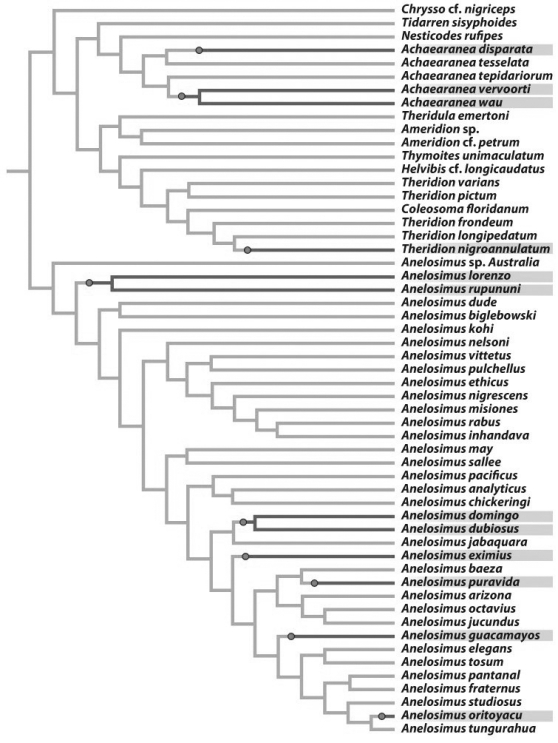 On the phylogeny of Theridiidae spiders illustrated above,shaded names indicate group-living species.Group living in this family has evolved
On the phylogeny of Theridiidae spiders illustrated above,shaded names indicate group-living species.Group living in this family has evolvedA)once.
C)nine times.
B)three times.
D)twelve times.

Unlock Deck
Unlock for access to all 42 flashcards in this deck.
Unlock Deck
k this deck
27
In studying transitions,why is it necessary to focus on the advantages to individuals before the transitions and not the group advantage?

Unlock Deck
Unlock for access to all 42 flashcards in this deck.
Unlock Deck
k this deck
28
The figure below illustrates the relationship between the distance to a food source and a portion of the honeybee dance in the hive.If a forager returned to the hive with food and did a straight run of 1.5 seconds,how far would other foragers go to find food? 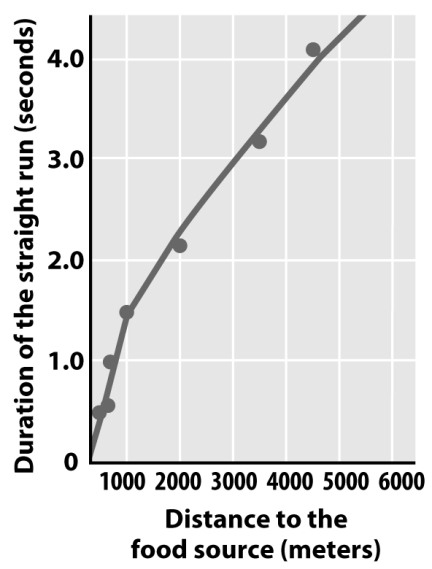
A)500 meters
C)2000 meters
B)1000 meters
D)4000 meters

A)500 meters
C)2000 meters
B)1000 meters
D)4000 meters

Unlock Deck
Unlock for access to all 42 flashcards in this deck.
Unlock Deck
k this deck
29
What are apicoplasts,and what is the advantage of using them as a drug target for the treatment of malaria?

Unlock Deck
Unlock for access to all 42 flashcards in this deck.
Unlock Deck
k this deck
30
Based on the figure below,would you expect all nonplant eukaryotes to have exactly the same mitochondrial genes as all plant mitochondria? Why or why not?
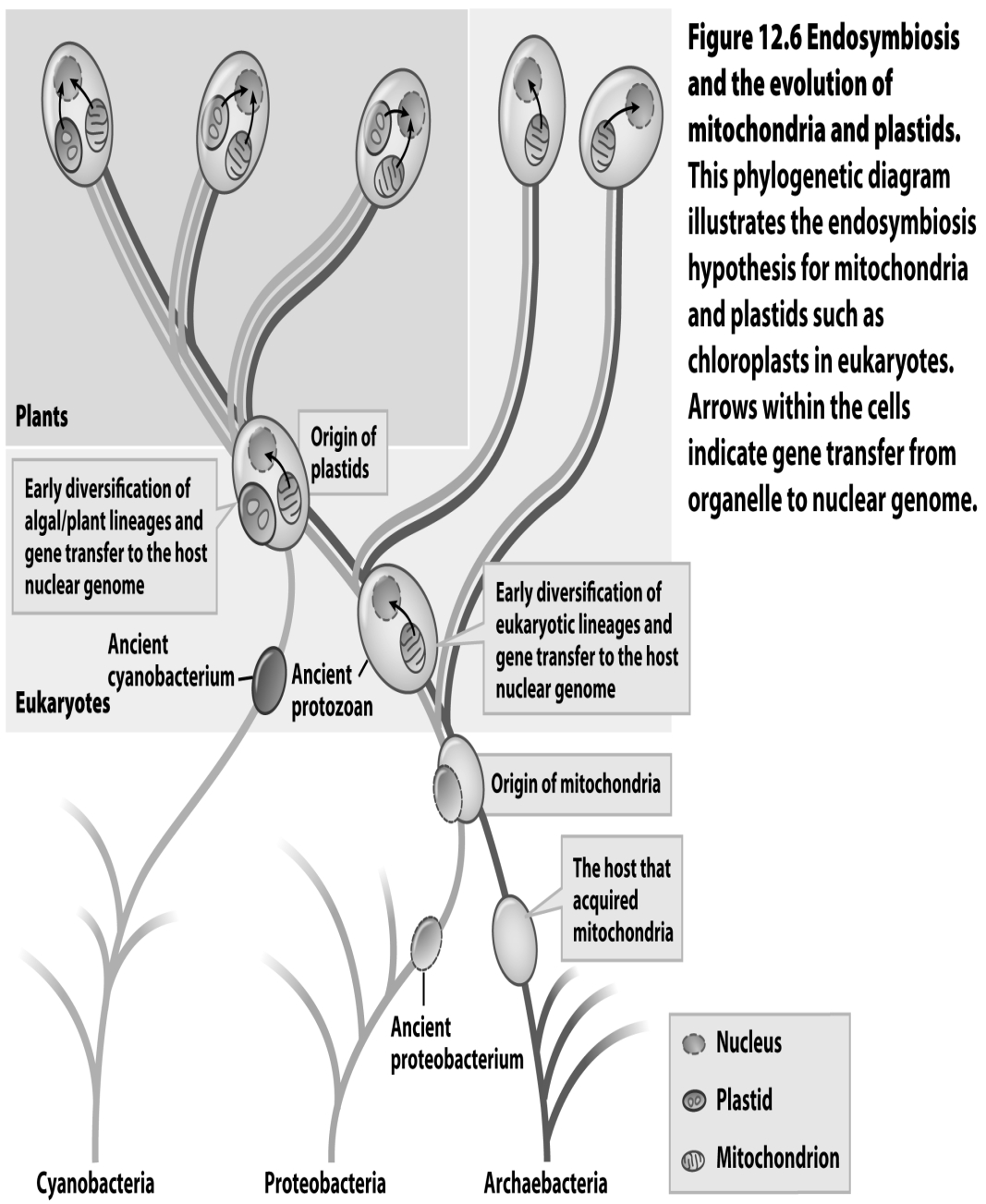


Unlock Deck
Unlock for access to all 42 flashcards in this deck.
Unlock Deck
k this deck
31
Why must cheaters be identifiable in group living at any level (e.g.,multicellularity or social groups)?

Unlock Deck
Unlock for access to all 42 flashcards in this deck.
Unlock Deck
k this deck
32
From where do the extra membranes arise in mitochondria,chloroplasts,and apicoplasts?
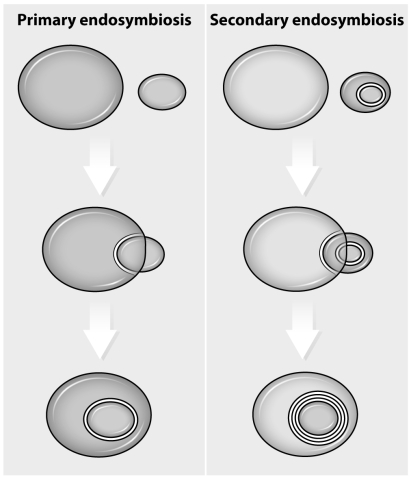


Unlock Deck
Unlock for access to all 42 flashcards in this deck.
Unlock Deck
k this deck
33
What is a social group?
A)Individuals that are always together.
B)Individuals that affect each other's fitness.
C)A group that forages together.
D)A group that shares communal raising of offspring.
A)Individuals that are always together.
B)Individuals that affect each other's fitness.
C)A group that forages together.
D)A group that shares communal raising of offspring.

Unlock Deck
Unlock for access to all 42 flashcards in this deck.
Unlock Deck
k this deck
34
The product of the regA gene in Volvox carteri suppresses the production of chloroplast proteins.The production of these chloroplast proteins causes cells to grow.When the regA gene is expressed
A)cells grow large and become germ cells.
B)cells stay small and become somatic cells.
C)cells grow flagella and become germ cells.
D)flagella growth is suppressed and cells become soma.
A)cells grow large and become germ cells.
B)cells stay small and become somatic cells.
C)cells grow flagella and become germ cells.
D)flagella growth is suppressed and cells become soma.

Unlock Deck
Unlock for access to all 42 flashcards in this deck.
Unlock Deck
k this deck
35
Which of the following is not a reason that volvocine algae are ideal for studying the evolution of individuality?
A)They transitioned to multicellularity relatively recently.
B)Within the group, there are multiple, separate transitions to germ and soma lines.
C)The group exhibits extensive variation in their degree of multicellularity.
D)They readily form aggregate slugs.
A)They transitioned to multicellularity relatively recently.
B)Within the group, there are multiple, separate transitions to germ and soma lines.
C)The group exhibits extensive variation in their degree of multicellularity.
D)They readily form aggregate slugs.

Unlock Deck
Unlock for access to all 42 flashcards in this deck.
Unlock Deck
k this deck
36
What do the four membranes of apicoplasts imply about the nature of the endosymbiosis event that produced them?

Unlock Deck
Unlock for access to all 42 flashcards in this deck.
Unlock Deck
k this deck
37
Why does genetic imprinting inhibit parthenogenesis?

Unlock Deck
Unlock for access to all 42 flashcards in this deck.
Unlock Deck
k this deck
38
Based on the figure below,if a plant and nonplant mitochondrial genome contain the same gene,do the organisms have a common ancestor? Why or why not?
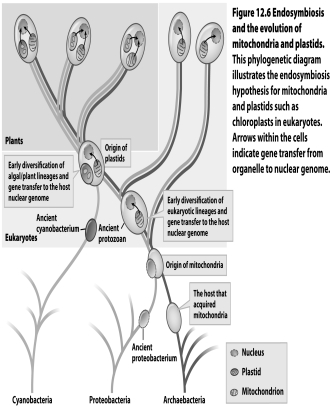


Unlock Deck
Unlock for access to all 42 flashcards in this deck.
Unlock Deck
k this deck
39
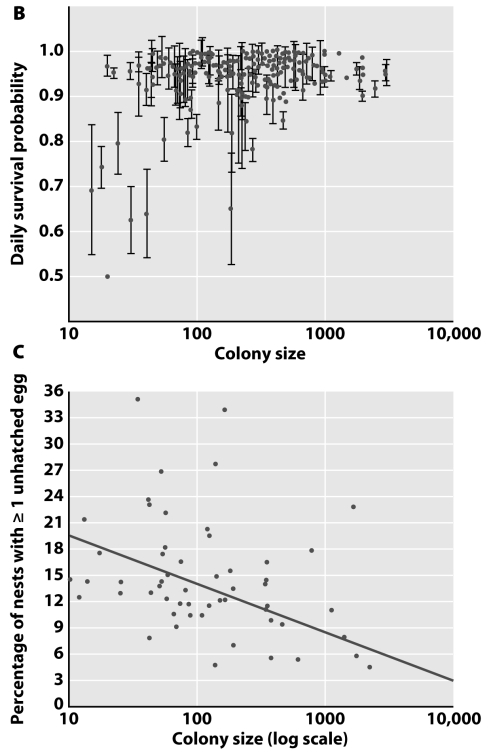 The benefits of colony living in cliff swallows are
The benefits of colony living in cliff swallows areA)increased adult survival and decrease in the number of hatched eggs.
B)increased adult survival and decrease in the number of unhatched eggs.
C)decreased adult survival and decrease in the number of hatched eggs.
D)decreased adult survival and decrease in the number of unhatched eggs.

Unlock Deck
Unlock for access to all 42 flashcards in this deck.
Unlock Deck
k this deck
40
Which of the following is a characteristic of an individual?
A)It is multicellular.
C)It is an integrated and indivisible whole.
B)It forms a group.
D)It is a eukaryote.
A)It is multicellular.
C)It is an integrated and indivisible whole.
B)It forms a group.
D)It is a eukaryote.

Unlock Deck
Unlock for access to all 42 flashcards in this deck.
Unlock Deck
k this deck
41
Draw a graph that illustrates the relationship between foraging ability and group size where group living is beneficial.On the same graph,draw a line of the relationship if group living was not beneficial.

Unlock Deck
Unlock for access to all 42 flashcards in this deck.
Unlock Deck
k this deck
42
Charles and Mary Brown have demonstrated that as cliff swallow colony size increases,the number of nests with one or more unhatched eggs decreases.They have also demonstrated that as the size of colony increases,the number of parasites increases,and these parasites cause nest failures and juvenile mortality.These two observations indicate that there are trade-offs in group living.What would be a better measure than unhatched eggs to understand the benefits of group living in cliff swallows?

Unlock Deck
Unlock for access to all 42 flashcards in this deck.
Unlock Deck
k this deck



